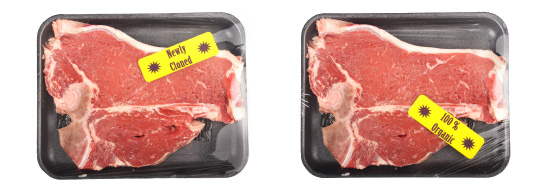
We all know that the meat industry is a dangerous threat to our climate and overall a questionable industry. The cattle release CO2, methane and other greenhouse gases. They also use a lot of land areas, around 25% of the earths total land area. And about one third of all farm areas are used to grow food for the cattle.
According to studies the meat industry is responsible for about one fifth of all greenhouse gas emissions, in the world. That means they currently pollutes more than the whole transport sector. And by year 2050 the meat production is expected to increase with 50%.
And then I haven't even mentioned the rather obvious animal suffering.
But maybe, if some "environmentally concerned scientists" get their way, the meat you'll eat in the future will be produced inside a lab. Scientists from the In Vitro Meat Consortium are currently trying to produce meat from muscle tissue for human consumption.
This laboratory-grown meat, or in vitro meat, should not be confused with "imitation meat", which often is produced from soy or gluten. The in vitro meat will be actual animal flesh, but flesh that never has been part of a living animal.
The in vitro meat would, according to the In Vitro Meat Consortium, be healthier and contain fewer diseases. It would also reduce animal suffering and have positive effect on the environment.
But some people are concerned that the in vitro meat will be of lesser quality and contain unresolved health risks than ordinary meat. Others worries that the in vitro meat will be different in appearance, taste, smell and even texture and thus reduce its appeal for consumers.
Either way the in vitro meat is far from the market today. More research needs to be done and there are currently several obstacles that need to be solved first:
- Proliferation of muscle cells: Although it is not very difficult to make stem cells divide, for meat production it is necessary that they divide at a quick pace. This requirement has some overlap with the medical branch of tissue engineering.
- Culture medium: Proliferating cells need a food source to grow and develop. The growth medium should be a well-balanced mixture of ingredients and growth factors. Depending on the motives of the researchers, the growth medium has additional requirements.
- Commercial: The growth medium should be cheap to produce.
- Environmental: The production of the growth medium shouldn't have a negative impact on the environment. This means that the production should be energetically favorable. Additionally, the ingredients should come from completely renewable sources. Minerals from mined sources are in this case not possible, as are synthetically produced nutrients which use non-renewable sources.
- Animal welfare: The growth medium should be devoid of animal sources, although they may initially be more useful than other sources.
- Space travel: The growth medium should be almost completely created from the waste products in the space ship, if it is to be used in space travel.
- Bioreactors: Nutrients and oxygen need to be delivered close to each growing cell, on the scale of millimeters. In animals this job is handled by blood vessels. A bioreactor should emulate this function in an efficient manner. The usual approach is the creation of a sponge-like matrix in which the cells can grow, and perfusing it with the growth medium.
Although more research needs to be done there is progress in this area, especially in Europe.
M. A. Benjaminson from Touro College performed the first, actual, research about in vitro meat. Benjaminson managed to grow muscle tissue from a goldfish in a laboratory setting.
And in 2004 researchers from Europe formed the non-profit organization New Harvest. According to them laboratory-grown meat in a processed form, like sausages and hamburgers, "may become commercially available within several years".
In April 2005 the Dutch government granted a two million euro subsidy for a laboratory-grown meat project by Henk Haagsman at the University of Amsterdam.
At a workshop held at the Norwegian University of Life Sciences on June 15, 2007 the In Vitro Meat Consortium was established with the goal "to facilitate the establishment of a large-scale process industry for the production of muscle tissue for human consumption through concerted R&D efforts and attraction of funding to fuel these efforts."

Recommended Comments
Join the conversation
You can post now and register later. If you have an account, sign in now to post with your account.